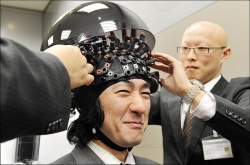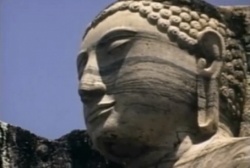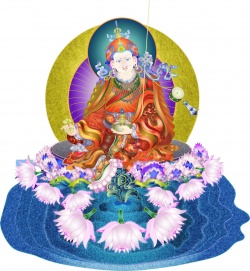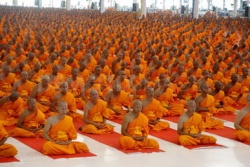Two Parts of Liberation, One Kind of Freedom
Two Parts of Liberation, One Kind of Freedom
两处解脱,一种自由
古往今来,十方佛子,随佛学法,无非谋求真实,出离苦海,为得解脱。所谓解脱,即解脱于一切能系、所系。解者解于幻,脱者脱于心。幻者是心幻,心者是幻心。所谓心幻即是法,幻心所生的产物,又名幻象;所谓幻心即是认取或抓着幻象的主体。
Throughout the ages, the Buddha's disciples of the ten directions study the dharma according to the Buddha with none other than the purpose of seeking the truth, escaping the sea of suffering for the purpose of obtaining liberation. That which is called liberation is the liberation from all 能系 (fabricator?) and 所系 (fabrication?). The unknoter unknots delusion, the sheder sheds mind (note: Chinese word of 'liberation' is 'unknot shed'). That which is deluded is mind-delusion, that which is mind is delusional mind. What is called mind delusion is dharma, the product of mind delusion is known as delusional appearance; that which is called deluded mind is the subject that recognizes or grasps onto delusional appearance.
因为有幻心所生的产物——幻象 (法),有生出幻象的主体——幻心,所以解脱也就有两处:所谓心解脱,法解脱。法解脱又名慧解脱。即解脱有两种,谓心解脱,慧解脱。所谓心解脱,即是心从 它一切旧有的习惯和对法尘的粘着中逃离;所谓慧解脱,即是认出一切法的真实本质,并从那个认知中出离。
Because there is the product of deluded mind – delusional appearance (dharma), and there is the subject that gave rise to delusional appearance – deluded mind, therefore liberation has two parts: mind-liberation and dharma-liberation. Dharma liberation is also called wisdom liberation. Liberation has two kinds, also known as mind liberation and wisdom liberation. What is known as mind liberation is the escape from all the old habits and adhesiveness towards dharma sense objects; what is known as wisdom liberation, is the recognition of the true essence of all dharmas, and thus escape/liberate from that recognition.
当认出心的本质,谓破掉心,又 名破掉“能”;当认出法的本质,谓破掉法,又名破掉“所”。破掉能,没有攀援的主体,故能于心处解脱;破掉所,没有所攀援的对象,故能于法处解脱。心解脱 者,认识到心非心,心无自性,心空;法解脱者,认识到法非法,法无自性,法空。解脱者以心空行于法空,究竟解脱。
When the mind's essence is recognised, it breaks away mind, also known as breaking the “subject”; when the true essence of dharma is recognized, it breaks away dharma, also known as breaking the “object”. Breaking away subject, there isn't a subject that grasps/seeks, hence there can be liberation of the mind; breaking away the object, there is no object of grasping/seeking, hence there can liberation of dharma. Those who are mind-liberated, recognize that mind is not mind, mind is devoid of self-nature, mind is empty; those who are dharma-liberated, recognizes that dharma is not dharma, dharma is devoid of self-nature, dharma is empty. Those who are liberated enters dharma emptiness from mind emptiness, attaining ultimate liberation.
修行者追求两处解脱、究竟解 脱,无非为获取一种自由,也只有一种自由,那就是,无法也无心的彻底的、绝对的自由。三世十方一切佛子谋求的就是这种自由。今日修行者也应当谋求这种自 由。为了达成这种自由,我们要:一致力于观心,二致力于观法。致力于观心,是基础,是前提;致力于观法是后续,是在这个基础上的更进一步。不行观心先行观 法的人,可能成为科学家但成不了解脱者;行于观心又行于观法的人,不但成为解脱者,还能成为最科学者。
The practitioner seeks for two kinds of liberation, the ultimate liberation, with none other than the purpose of obtaining one kind of freedom, and there is only one kind of freedom, which is, the absolute and complete freedom of no dharma and no mind. In order to reach this kind of freedom, we have to: 1) be dedicated to contemplating/observing mind, 2) be dedicated to contemplating/observing dharma. Being dedicated to contemplating mind is the foundation, it is the premise; being dedicate to contemplating/observing dharma is the follow-up, it is the further step of this foundation. The person who does not practice contemplating/observing the mind but first contemplates/observes the dharma, can possibly become a scientist but will not become a liberated person; the person who practices contemplating the mind and further practices contemplating the dharma, not only can become liberated, that person can also become a most scientific person.
观心达成的是心解脱,对付的是 烦恼障;观法达成的是慧解脱,对付的是所知障。当你突破烦恼障,你得心解脱;当你突破所知障,你得慧解脱。烦恼的有无,是心解脱的标志;所知惑的有无,慧 解脱的标志。检测有没有心解脱,看你还有没有烦恼;检测有没有慧解脱,看你还有没有知见上的困惑。实际上,彻底的心解脱的人包含了慧解脱,彻底的慧解脱的 人包含了心解脱。因为心和法,原本就是一,而非二。
Contemplating mind leads to the attainment of mind liberation, it deals with the obscuration of affliction/suffering*; contemplating dharmas lead to the attainment of wisdom liberation, it deals with knowledge obscuration*. When you overcome the obscuration of affliction/suffering, you obtain mind liberation; when you overcome the obscuration of knowledge, you attain wisdom liberation. The presence or absence of suffering is the sign of mind liberation; the presence or absence of the obscuration of knowledge is the sign of wisdom liberation, that is whether or not there is still the obscuration of views. In reality, the person who has thoroughly mind-liberated also contains wisdom-liberation, and the thoroughly wisdom-liberated person also contains mind-liberation. This is because mind and dharma, originally are one, not two.
因于解脱的上述两个目标或处 所,佛陀(解脱)的教法也大体分为两类:一曰小乘,二曰大乘。所谓小乘,谓致力于心解脱者,主要目标是彻底的灭除烦恼,现今南传佛教一派即是,它的教典多 是对身心现象的观察和认识方法。所谓大乘,谓致力于法解脱者,其目标是灭除一切法惑,即今北传佛教一派即是,它的教典多是对种种法的诠释。大乘小乘也可以 不将它看做两种派别,而是一个究竟解脱过程的两个阶段。
Due to the two goals as described above, the teachings of Buddha (liberation) has generally two kinds: 1) Hinayana 2) Mahayana. The so-called Hinayana are those that are dedicated on mind-liberation, with the main goal of thoroughly extinguishing suffering, currently the Southern Tradition (Theravada) is it, its scriptures deal with various methods of contemplating and recognizing the various mind-body phenomena. The so-called Mahayana consists of those that are dedicated on wisdom-liberation, and its main goal is to extinguish all obscurations of dharma. Currently the Northern Tradition is it, its scriptures are mostly dealing with various annotations on dharma. Mahayana and Hinayana can also be seen not as two different types of sects, but instead as a two-stage process towards ultimate liberation.
也可以这样说,佛教有两大任 务:一是人生观,二是世界观。所谓小乘,它的主要任务是“观人生”,解决的是人生观问题;所谓大乘,它的主要的任务是“观世界”,解决的是世界观问题。关 于人生观和世界观的问题,先解决人生观的问题,再解决世界观的问题。如果一人连他生命本身的问题都没解决,关注有关世界的问题变得很荒唐和无意义。也就 是,未明白“我”的人,别去思考世界;未搞定“我”的人,别去探索诸法。修行者先行心解脱,再行法解脱!
It can also be said in this way, Buddhism has two major tasks: 1) outlook of human life, 2) outlook of the world. Hinayana's main task is “contemplating human life”, it solves the problem on the outlook of human life; whereas Mahayana's main task is “contemplating the world”, it solves the problem of the outlook of the world. With regards to the outlook of human life and the outlook of the world, first we should resolve the problem of the outlook of human life, followed by the problem of the outlook of the world. If a person has not even solved the problems of his own life, it is ridiculous and meaningless to be concerned with the problems of the world. That is, those who have not understood “Self”, should not think about the world; those who have not sorted out the “Self”, should not explore the various dharmas. Practitioners should first practice freeing one's mind, then practice liberating the dharmas!
对我而言,小乘是心解脱的代名 词,大乘是法解脱的代名词;小乘是一批处理“心”问题的人,大乘是一批是处理“法”问题的人。小乘致力于人生观问题的解决,大乘致力于世界观问题的解决; 小乘是一批观察和思考人生的人,大乘是一批观察和思考世界的人。请完成你的小乘课,再完成大乘课。当你的小乘课完成得好,大乘的课不成问题,因为那是顺理 成章的事。学习佛陀教法的人,完成好这两门课。两处解脱,一种自由!
To me, Hinayana is synonymous with mind liberation, Mahayana is synonymous with dharma liberation; Hinayana is a batch of people dealing with the problems of “mind”, Mahayana is a batch of people dealing with the problems of “dharma”. Hinayana emphasizes solving the problems relating to the outlook of human life, whereas Mahayana emphasizes solving the problems relating to the oulook of the world. Please complete your Hinayana class, then finish up your Mahayana class. When you complete your Hinayana class well, Mahayana class will no longer be a problem, because that is the logical and coherent (course of things?). Those who are learning the Buddhadharma should complete these two classes. Two kinds of liberation, one type of freedom!
http://www.dharmadownload.net/pages/english/Natsok/0010_Teaching_English/Teaching_English_0097.htm
To attain liberation, we need to eliminate our obscurations, which is why we learn about them. The two main categories of obscurations are the obscuration of the defilements and the obscuration of knowledge.
(1) The obscuration of the defilements are all negative thoughts and emotions that arise in our mind, such as pride, miserliness, jealousy, stupidity, anger, maliciousness, and so on. The presence of these defilements impedes us from practicing the Dharma correctly. Our defilements prevent us from attaining liberation and from benefitting others. To achieve Buddhahood, we need to eliminate our obscuration of the defilements.
(2) The obscuration of knowledge does not pertain to obvious thoughts by means of which we create defilements, such as thoughts of anger and so on. Rather, it means being and becoming increasingly habituated to an attitude that contradicts and stands in opposition to the true nature of all inner and outer things.
We have the innate tendency to think that appearances and experiences have a true existence, whereby “true” in this context means ‘independent.’ This innate tendency consists of three aspects that are spontaneously present while we are engaged in activities. The three aspects are: (a) Believing in the true existence of the subject, i.e., “our self”; (b) believing in the true existence of the object upon which we carry out an action; and (c) believing in the true existence of the action itself. Believing in and being attached to these three aspects of the obscuration of knowledge prevent us from attaining realisation of the actual nature of all inner and outer phenomena. They need to be overcome so that the obscuration of knowledge is eliminated.




